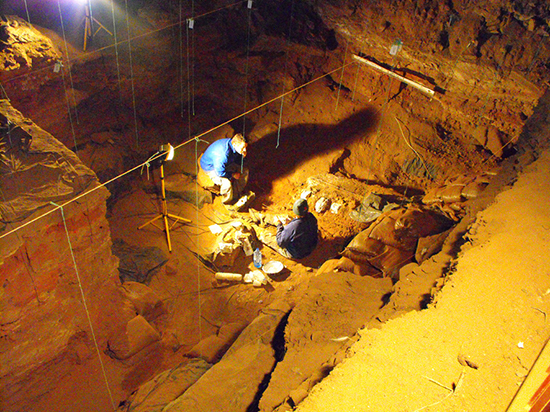Latest News Archive
Please select Category, Year, and then Month to display items
05 June 2018
Photo Supplied
 Archaeological excavations in the Wonderwerk Cave, north of Kuruman in the Northern Cape.
Archaeological excavations in the Wonderwerk Cave, north of Kuruman in the Northern Cape.
Research fellow Dr Lloyd Rossouw from the Department of Plant Sciences at the University of the Free State (UFS) recently published an article in the Nature Ecology and Evolution journal with Dr Michaela Ecker from the University of Toronto as lead author, and Dr James Brink, research fellow at the UFS Centre for Environmental Management. The findings described in “The palaeoecological context of the Oldowan-Acheulean in southern Africa” provides the first extensive paleoenvironmental sequence for the interior of southern Africa by applying a combination of methods for environmental reconstruction at Wonderwerk Cave, which have yielded multiple evidence of early human occupation dating back almost two million years ago.
Where water once was
The Wonderwerk Cave is found north of the Kuruman hills (situated in Northern Cape) a 140m long tube with a low ceiling. The surroundings are harsh. Semi-arid conditions allow for the survival of only hardy bushes, trees, and grasses. But during the Early Pleistocene, stepping out of the Wonderwerk Cave you would have been greeted by a completely different site, the researchers found. Using carbon and oxygen stable isotope analysis on the teeth of herbivores (Dr Ecker), fossil faunal abundance (Dr Brink), as well as the analysis of microscopic plant silica remains (phytoliths) excavated from fossil soils inside the cave (Dr Rossouw), the results show that ancient environments in the central interior of southern Africa were significantly wetter and housed a plant community unlike any other in the modern African savanna.
What difference does it make?
While East African research shows increasing aridity and the spread of summer-rainfall grasslands more than a million years ago, the results from this study indicate an interesting twist. During the same period, shifts in rainfall seasonality allowed for alternating summer and winter-rainfall grass occurrences coupled with prolonged wetlands, that remained major components of Early Pleistocene (more or less the period between one and two million years ago) environments in the central interior of southern Africa. That means our human ancestors were also living and evolving in environments other than the generally accepted open, arid grassland model.
Delegation from university in Mexico visits the UFS
2009-09-01
 |
From the left are: Prof. Schalk Louw, Prof. Wijnand Swart, Dr Victor Pinto, UACH, Dr Lizel Hugo, National Museum, Dr Nahum Marban, UACH, Ms Henda Landman, Department of Zoology and Entomology at the UFS, Ms Louise Coetzee, National Museum, Mr Vaughn Swart, Department of Zoology and Entomology at the UFS, Dr Samuel Ramirez, UACH, and Dr Driekie Fourie, ARC-Grain Crops Institute in Potchefstroom.
Photo: Mangaliso Radebe
|
| A delegation from the Autonomous University of Chapingo (UACH) in Texcoco, Mexico visited the University of the Free State (UFS) recently to hold exploratory discussions with various scientists affiliated to the Faculty of Natural and Agricultural Sciences, including the Centre for Plant Health Management (CePHMa). The visit builds on an institutional agreement that was signed between CePHMa and the University of Chapingo in 2006. The Mexican delegation was hosted by Prof. Wijnand Swart, Cluster Director: Technologies for Sustainable Crop Industries in Semi-arid regions, and consisted of Dr Victor Pinto (entomologist), Dr Samuel Ramirez (entomologist) and Dr Nahun Marban (nematologist). Prof. Schalk Louw from the Department of Zoology and Entomology at the UFS chaired a meeting with the three Mexican visitors and colleagues specialising in in acarology and nematology from the National Museum in Bloemfontein and the ARC-GCI in Potchefstroom, respectively. Discussions focused mainly on opportunities for collaborative research and student exchange between the aforementioned institutions and University of Chapingo. |